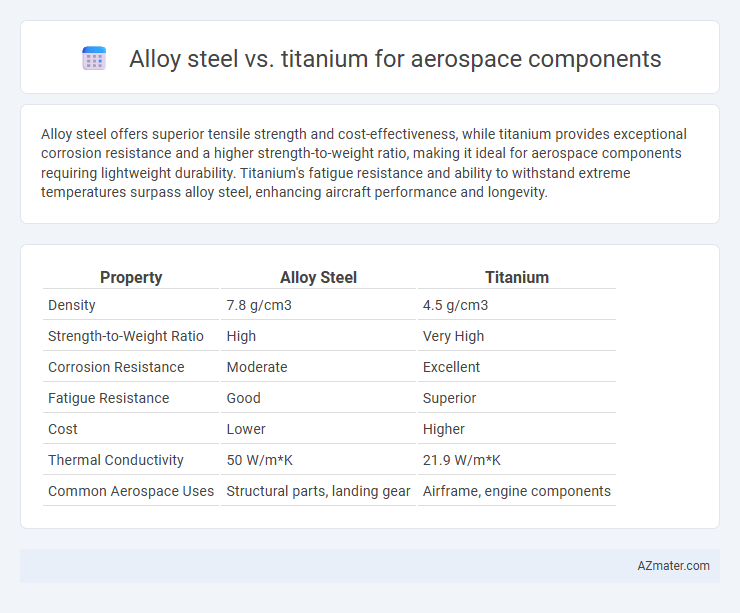Alloy steel offers superior tensile strength and cost-effectiveness, while titanium provides exceptional corrosion resistance and a higher strength-to-weight ratio, making it ideal for aerospace components requiring lightweight durability. Titanium's fatigue resistance and ability to withstand extreme temperatures surpass alloy steel, enhancing aircraft performance and longevity.
Table of Comparison
| Property | Alloy Steel | Titanium |
|---|---|---|
| Density | 7.8 g/cm3 | 4.5 g/cm3 |
| Strength-to-Weight Ratio | High | Very High |
| Corrosion Resistance | Moderate | Excellent |
| Fatigue Resistance | Good | Superior |
| Cost | Lower | Higher |
| Thermal Conductivity | 50 W/m*K | 21.9 W/m*K |
| Common Aerospace Uses | Structural parts, landing gear | Airframe, engine components |
Introduction to Aerospace Materials
Alloy steel and titanium are critical materials in aerospace engineering due to their unique mechanical properties and weight considerations. Alloy steel offers high strength and durability, suitable for structural components subjected to heavy loads, while titanium provides an exceptional strength-to-weight ratio and corrosion resistance, ideal for weight-sensitive parts like airframe structures and engine components. The selection between these materials balances performance, cost, and specific application demands within aerospace manufacturing.
Key Properties of Alloy Steel
Alloy steel is prized in aerospace applications for its high tensile strength, excellent fatigue resistance, and superior durability under extreme stress conditions. Its enhanced hardness and resistance to wear and corrosion make it suitable for critical components exposed to harsh environments. Alloy steel's cost-effectiveness and adaptability to heat treatment processes provide a significant advantage over titanium in certain structural parts.
Key Properties of Titanium
Titanium exhibits exceptional strength-to-weight ratio, corrosion resistance, and high-temperature stability, making it ideal for aerospace components requiring durability and reduced weight. Its excellent fatigue resistance and ability to withstand extreme environmental conditions ensure long service life in aircraft structures. Compared to alloy steel, titanium's lower density significantly enhances fuel efficiency and performance in aerospace applications.
Strength and Weight Comparison
Alloy steel offers high tensile strength and excellent fatigue resistance, making it suitable for load-bearing aerospace components, but it is significantly heavier than titanium. Titanium provides a superior strength-to-weight ratio, reducing overall aircraft weight and improving fuel efficiency while maintaining corrosion resistance and durability. Choosing titanium over alloy steel enhances performance in aerospace applications where minimizing weight without compromising strength is critical.
Corrosion Resistance in Aerospace Environments
Titanium exhibits superior corrosion resistance compared to alloy steel in aerospace environments due to its stable oxide film, which protects against oxidation, salt spray, and high humidity. Alloy steels often require protective coatings or treatments to prevent rust and degradation under similar conditions, increasing maintenance demands. The inherent corrosion resistance of titanium enhances component longevity and reliability, making it a preferred choice for critical aerospace parts exposed to harsh atmospheres.
Machinability and Fabrication Challenges
Alloy steel exhibits superior machinability compared to titanium, benefiting from established tooling techniques and higher cutting speeds, which reduces fabrication time for aerospace components. Titanium, while offering exceptional strength-to-weight ratio and corrosion resistance, presents significant fabrication challenges due to its low thermal conductivity and tendency for rapid tool wear, necessitating specialized machining processes. The trade-off between alloy steel's easier machinability and titanium's performance advantages is critical when optimizing aerospace component manufacturing efficiency and durability.
Cost Analysis: Alloy Steel vs Titanium
Alloy steel offers a significantly lower material cost compared to titanium, making it a more budget-friendly option for aerospace components where cost constraints are critical. Titanium's higher price is driven by its complex extraction and processing methods, but its superior strength-to-weight ratio and corrosion resistance can result in long-term savings through improved fuel efficiency and reduced maintenance. Cost analysis must also consider lifecycle expenses, where titanium often outperforms alloy steel despite its initial higher investment.
Applications in Modern Aircraft
Alloy steel provides high strength and toughness, making it ideal for landing gear, engine components, and structural parts in modern aircraft where durability under stress is critical. Titanium excels in components requiring exceptional corrosion resistance, high strength-to-weight ratio, and thermal stability, such as airframe structures, engine blades, and fasteners. The strategic use of titanium significantly reduces overall aircraft weight, enhancing fuel efficiency and performance while alloy steel ensures reliability in high-impact applications.
Sustainability and Lifecycle Considerations
Alloy steel offers high strength and cost-effectiveness but is heavier and more prone to corrosion, impacting its sustainability in aerospace applications. Titanium provides superior strength-to-weight ratio, excellent corrosion resistance, and longer lifecycle, significantly reducing maintenance and replacement frequency. The environmental footprint of titanium production is higher initially, yet its durability and recyclability enhance overall lifecycle sustainability compared to alloy steel.
Future Trends in Aerospace Material Selection
Future trends in aerospace material selection emphasize lightweight, high-strength alloys like titanium due to their superior corrosion resistance and fatigue performance compared to traditional alloy steels. Emerging titanium matrix composites and advanced alloy steel formulations aim to balance cost-efficiency with enhanced mechanical properties and thermal stability for next-generation aircraft. Adoption of additive manufacturing techniques also accelerates the integration of novel titanium and alloy steel materials, enabling complex geometries and optimized weight-to-strength ratios.

Infographic: Alloy steel vs Titanium for Aerospace component
 azmater.com
azmater.com